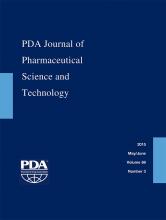Abstract
Brevundimonas diminuta is the organism most commonly used for challenge testing of sterilizing-grade filter membranes. ASTM F838-05 and PDA Technical Report 26 rely on B. diminuta ATCC #19146 for standard challenge tests used to designate sterilizing-grade filter performance. Despite the importance and widespread use of B. diminuta in filter testing and validation, information about this microorganism in its native hydrated state is limited. In this work, we measure, for the first time, the mechanical property of modulus for B. diminuta cultured in saline lactose broth (as described in ASTM F838-05) via wet atomic force microscopy. For comparison, we also imaged B. diminuta by the traditional method of electron microscopy after capture on a filter and chemical fixation. The modulus of hydrated B. diminuta cells was ∼193 mPa. To put this result into context, a simple model for pore penetration that correlates the role of the Young's modulus of hydrated cells to the penetration of sterilizing-grade filters is proposed. The model confirms the industry experience that pore size is an essential parameter in preventing the penetration of B. diminuta into sterilizing-grade filters.
LAY ABSTRACT: The small microorganism Brevundimonas diminuta is used to characterize the performance of sterilizing-grade filter membranes used in the manufacturing of sterile drug products. Little is known about the size, shape, or elasticity of living bacterial cells, as it is easier to characterize bacteria after chemical fixation in a dry state. In this work, we use atomic force microscopy to determine the size, shape, and deformability of this important microorganism while it is alive and fully hydrated. Additionally, we compare the physical and mechanical properties of B. diminuta measured in wet and dry states. This information can be used to advance our understanding of how filter membranes remove these organisms from fluid streams.
- © PDA, Inc. 2015
PDA members receive access to all articles published in the current year and previous volume year. Institutional subscribers received access to all content. Log in below to receive access to this article if you are either of these.
If you are neither or you are a PDA member trying to access an article outside of your membership license, then you must purchase access to this article (below). If you do not have a username or password for JPST, you will be required to create an account prior to purchasing.
Full issue PDFs are for PDA members only.
Note to pda.org users
The PDA and PDA bookstore websites (www.pda.org and www.pda.org/bookstore) are separate websites from the PDA JPST website. When you first join PDA, your initial UserID and Password are sent to HighWirePress to create your PDA JPST account. Subsequent UserrID and Password changes required at the PDA websites will not pass on to PDA JPST and vice versa. If you forget your PDA JPST UserID and/or Password, you can request help to retrieve UserID and reset Password below.






